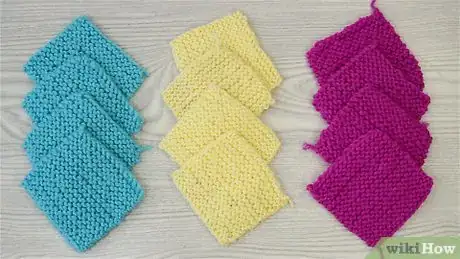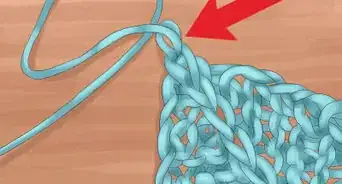This article was co-authored by Lois Wade and by wikiHow staff writer, Hannah Madden. Lois Wade has 45 years of experience in crafts including sewing, crochet, needlepoint, cross-stitch, drawing, and paper crafts. She has been contributing to craft articles on wikiHow since 2007.
There are 16 references cited in this article, which can be found at the bottom of the page.
This article has been viewed 645,498 times.
A nice, warm, knitted blanket pairs perfectly with a good book on a cold night. A blanket is a long-term project, but you can always pick the project up when you have the time. Plus, when it's finished, the sense of achievement will make it all worthwhile! You can use a variety of knitting techniques and stitch patterns to create a unique and beautiful blanket to keep for yourself or give away as a gift.
Steps
Patch Blanket
-
1Base the size of your patches on how big your blanket will be. Depending on what size blanket you’d like to have, you can make your patches big, small, or anywhere in between. Generally, a 3 by 4 ft (0.91 by 1.22 m) blanket will use patches that are 5 inches (13 cm), a 4 by 6 ft (1.2 by 1.8 m) blanket will use ones that are 8 inches (20 cm), and a 6 by 8 in (15 by 20 cm) blanket will have patches that are 12 inches (30 cm).[1]
- The amount of yarn you need depends on the weight of your yarn and your blanket size. In general, you’ll need between 650 and 1,500 yd (1,950 and 4,500 ft).
-
2Knit 1 line of yarn using the cast on stitch. Make a simple slipknot with your yarn and slide it over your left-hand knitting needle. Wrap the yarn around your thumb, then slide the yarn loop onto the knitting needle again. Pull your thumb out of the yarn, then tug on both ends to tighten the knot. Keep repeating this stitch until you have 1 side of your square patch done.[2]
- This is one of the easiest ways to start a knitting project, and you’ll probably use it a lot later on in other projects, too.
- For this project, you’ll want size 19 US (000 UK) knitting needles if you’re using bulky yarn, or size 15 US (000 UK) knitting needles if you’re using medium-weight yarn.
Advertisement -
3Slide your right-hand needle into the excess thread to keep knitting. Grab your second knitting needle and bring the point up close to the point of your left-hand needle. Wrap the loose yarn clockwise around the top of the right needle, keeping the yarn wrapped tightly as you move along. Pull the right-hand needle backwards just slightly, then slide it up through the closest loop on your left needle. Keep going down the line to complete one row.[3]
- When you’ve finished a row, you can move your empty needle back to the side with the working yarn to start a new one. Then, you can continue on using rows until you’ve made an even square.
- If you reach the end of a ball of yarn, just cast on again with your new length of yarn to keep going.
- This is a basic knit stitch, and it’s useful to learn when you’re making blankets, scarves, or hats.
-
4Finish the square by casting off. Once you’re done with your patch, you’ll still have yarn wrapped around your left-hand needle. Take your empty needle (the right-hand needle) and bring it up to the point of the left needle again. Knit 2 basic stitches using the loops attached to the left-hand needle, looping the stitches onto your right needle. Then, use the point of your left needle to grab the first stitch on the right needle and pull it up and over the second stitch.[4]
- Continue casting off until you’ve removed all of the stitches from both needles.
- You’ll be left with a square patch of yarn that you can use to create your blanket!
-
5Make 12 equal squares. To complete your blanket, keep making even squares in the same size as your first one. Once you’ve made 12 squares, you can stop and arrange your blanket.[5]
- Knitting this many squares can take a long time, especially if you’ve never knitted before. Don’t be afraid to put down your project and pick it back up again later.
-
6Arrange your squares in a blanket pattern. Once you have all 12 squares, spread them out on a flat surface to see how they’ll look in your finished blanket. You can use your creativity here to make a pattern, mix and match colors, and try out different numbers in different rows.[6]
- It’s helpful to spread all of the patches out before you move on so you can visualise how your blanket will look in the end.
- You can even alternate the patches in a right side up, wrong side up pattern.
-
7Sew each square together with an invisible seam. Position 2 of the squares next to each other and line up the edges. Thread a large sewing needle with a new length of yarn, then poke it into the edge of 1 square. Bring your needle up and through the yarn, then poke it through the edge of the second square, sewing them tightly together (kind of like a running stitch). Keep going back and forth up the 2 squares with stitches that are about 0.5 in (1.3 cm) apart until you reach the top.[7]
- The invisible seam is great for knitting 2 pieces of knit-work together. It’s a very versatile stitch that will probably come in handy during other projects, too.
- Once you’re done, you’ll have a soft, cozy blanket with a fun, funky pattern to snuggle up under.
- If you attach all of your squares and realize your blanket isn’t as big as you’d like it to be, you can just knit a few more patches and add them onto the ends.
Solid-Colored Blanket
-
1Cast on 210 stitches on your needle. To start a plain blanket, grab your knitting needle and make a simple slip knot with your yarn, pulling it over the tip of your left-hand needle to get started. Wrap the yarn around your thumb, then slide that loop onto the needle to attach your yarn. Tug on both loose ends of the yarn to tighten up the knot, then keep going with this stitch.[8]
- The length of your initial stitching will be the width of your blanket, so you can make it as long or as short as you’d like. This may be slightly more or less than 210 stitches, so you can play around with the number that you need.
- A blanket with 210 stitches will be about 4 ft (1.2 m) wide.
- As you might have guessed, you’re going to need a long knitting needle for this blanket. Try to get size 7 US (7 UK) knitting needles for lightweight yarn or size 10 US (4 UK) knitting needles for bulky yarn.
- Depending on how large your blanket is, this project can take 650 and 1,500 yd (1,950 and 4,500 ft) of yarn.
-
2Make the second row with a basic knit stitch. Take the empty needle in your right hand and bring the point up to the last stitch you just made. Wrap the loose yarn, or the working yarn, clockwise around your right-hand needle, then pull the right-hand needle backwards just slightly. Slide your needle up through the loop of yarn, then pull the loop onto the right needle. Keep going with this stitch to make the second row of your blanket.[9]
- Creating a plain blanket is all about making small strips of stitching. When they’re all finished, you’ll have an entire blanket!
-
3Keep stitching rows of yarn until your blanket is done. When you’ve finished a row, move your empty needle back over to the side with the working yarn and start again. You can use your basic knit stitch to keep going down the length of your blanket, stopping when you run out of yarn or your blanket is long enough to cozy up in. This can take quite a while, so don’t be afraid to put your project down and pick it back up again later.[10]
- This is a great way to practice your basic knit stitch.
- The length of your blanket is up to you, but most solid-colored blankets end up being about 4 to 6 feet (1.2 to 1.8 m) long.
- If you reach the end of a ball of yarn, cast on again with a new length of yarn to keep going.
-
4Cast off the last stitches when you reach the end. When you’re finally done with your blanket, take your empty needle and slide it underneath the last stitch you made. Do 2 basic stitches, then use the left needle to slide the first loop up and over the second loop, keeping them on the right needle. Keep going until there aren’t any more stitches wrapped around your left-hand needle.[11]
- This is also called a “bind off.”
-
5Pull the tail of the yarn through the last loop. To make sure your blanket doesn’t unravel, take the tail end and pull it back through the loop hanging off the blanket. Pull the tail end taut to secure the knot in place and keep all your stitches tight.[12]
-
6Stitch the tail end of the yarn through the outer edge of the blanket. Take a size D crochet hook and thread the tail end of your yarn through it, leaving 1 to 2 inches (2.5 to 5.1 cm) hanging out of the back. Use your crochet hook to thread the tail end into the border of your blanket for 2 to 3 inches (5.1 to 7.6 cm) to secure the tail. When you’re done, use scissors to snip the excess yarn off.[13]
- This will keep your blanket secure without adding a ton of bulk to the outer edge.
Striped Blanket
-
1Cast on the first 20 stitches. Wrap the length of yarn around your thumb and hold it in place to make a simple slip knot. Slide the loop over your left-hand needle, then remove your thumb and grab the 2 loose ends. Pull them taut to tighten the knot, then repeat this stitch 20 times.[14]
- For striped blankets, you can alternate your yarn color to make them interesting to look at.
- If you’re making a baby blanket, try using muted colors that go with the color of their nursery.
- You’ll need size 10 US (4 UK) knitting needles for bulky yarn and size 7 US (7 UK) knitting needles for lightweight yarn.
- The amount of yarn you’ll need depends on the size of your project, but it’s best to start with 650 to 1,500 yd (1,950 to 4,500 ft).
-
2Use a knit stitch to stitch the width of your stripe. Now you can decide how wide you’d like your stripes to be—most are between 3 and 5 inches (7.6 and 12.7 cm) thick. Grab your right knitting needle and bring it up to the last loop you made. Wrap the working yarn around your right-hand needle, then draw it back just slightly to slide it through the last loop on your left-hand needle.[15]
- When you reach the end of one row, move your empty needle to the side of the row with the working yarn and start again.
- You can stop once you’ve completed a single stripe, but don’t cast off yet!
-
3Wrap your new yarn color around your empty needle to switch colors. Take the end of your empty needle and bring it up to the last stitch you made like you’re going to do a knit stitch. Instead of wrapping the last yarn color around your needle, grab your new color and wrap it once around the needle. Continue knitting on top of the previous row with your new yarn color to switch to a new stripe.[16]
- This is an easy way to switch between colors and avoid dealing with seam stitches.
- You can leave the excess yarn from your last color sticking out in a tail. When your blanket is done, just cut it off.
-
4Keep using a basic knit stitch to complete the rest of your blanket. You can add as many new colors and stripes as you’d like to until you finish up. If you’re making a baby blanket, you’ll probably want it to be about 2 or 3 feet (0.61 or 0.91 m) long; for an afghan or a throw, you might want it to be around 5 to 6 feet (1.5 to 1.8 m) long.[17]
- The length and pattern of your blanket is totally up to you, so get creative with it!
-
5Cast off the end of your stitches. Take your empty needle and slide it under the last loop you made. Do 2 knit stitches, then use your left-hand needle to slide the first loop up and over the back of the right-hand needle. Keep going until you’ve removed all of the yarn from your left-hand needle.[18]
-
6Weave the yarn tail into the edge of the blanket. Pull the tail end of the yarn through the last loop sticking out of your blanket, then thread it through a size D crochet hook. Use your crochet hook to weave the tail into the first 2 to 3 inches (5.1 to 7.6 cm) on the edge of your blanket, then use scissors to snip the end off when you’re done.[19]
- Now you can throw your blanket on the back of your couch or give it as a present during a baby shower.
Community Q&A
-
QuestionHow many balls of yarn will I need for this project?
 wikiHow Staff EditorThis answer was written by one of our trained team of researchers who validated it for accuracy and comprehensiveness.
wikiHow Staff EditorThis answer was written by one of our trained team of researchers who validated it for accuracy and comprehensiveness.
Staff Answer wikiHow Staff EditorStaff AnswerIt depends on the size of your blanket! Try starting out with 3 to 4 balls of yarn and going from there.
wikiHow Staff EditorStaff AnswerIt depends on the size of your blanket! Try starting out with 3 to 4 balls of yarn and going from there. -
QuestionHave 16-ply yarn, want to make a cot-sized blanket. How should l cast on my needles?
 MicheleTop AnswererFirst create a gauge so you know what size needles to use and how much yarn it will take to make the size you want. Then you can use any ply yarn, or even multiple yarns together to create your blanket. Gauge lets you know how many stitches per inch you can get based on yarn weight, needle size and your style of knitting. Some knit tight, some people knit loose, which why it's an important thing to know when you're trying to make something a specific finished size, whether it's a sweater or a cot blanket.
MicheleTop AnswererFirst create a gauge so you know what size needles to use and how much yarn it will take to make the size you want. Then you can use any ply yarn, or even multiple yarns together to create your blanket. Gauge lets you know how many stitches per inch you can get based on yarn weight, needle size and your style of knitting. Some knit tight, some people knit loose, which why it's an important thing to know when you're trying to make something a specific finished size, whether it's a sweater or a cot blanket. -
QuestionWhat is the best method for picking up a dropped stitch?
 LibraryMouseCommunity AnswerUse a crochet hook or your fingers to pull the loop through the horizontal strings one at a time.
LibraryMouseCommunity AnswerUse a crochet hook or your fingers to pull the loop through the horizontal strings one at a time.
Things You'll Need
Patch Blanket
- Between 650 and 1,500 yd (1,950 and 4,500 ft) of yarn
- 19 US (000 UK) or size 15 US (000 UK) knitting needles
- Sewing needle
- Ruler
Solid-Colored Blanket
- Size 7 knitting needles
- Between 650 and 1,500 yd (1,950 and 4,500 ft) of yarn
- Size D crochet hook
Striped Blanket
- 10 US (4 UK) or size 7 US (7 UK) knitting needles
- Between 650 and 1,500 yd (1,950 and 4,500 ft) of yarn
- Size D crochet hook
References
- ↑ https://www.woolandthegang.com/blog/2016/12/on-the-first-day-of-christmas
- ↑ https://www.youtube.com/watch?v=4XXky5Mo5p8&feature=youtu.be&t=88
- ↑ https://www.youtube.com/watch?v=4XXky5Mo5p8&feature=youtu.be&t=218
- ↑ https://www.youtube.com/watch?v=4XXky5Mo5p8&feature=youtu.be&t=426
- ↑ https://www.woolandthegang.com/blog/2016/12/on-the-first-day-of-christmas
- ↑ https://www.woolandthegang.com/blog/2016/12/on-the-first-day-of-christmas
- ↑ https://www.woolandthegang.com/blog/2016/12/on-the-first-day-of-christmas
- ↑ https://www.youtube.com/watch?v=6dAE8o59Z8M&feature=youtu.be&t=881
- ↑ https://www.youtube.com/watch?v=SXSYgBNiVI4&feature=youtu.be&t=317
- ↑ https://www.youtube.com/watch?v=6dAE8o59Z8M&feature=youtu.be&t=1408
- ↑ https://www.youtube.com/watch?v=SXSYgBNiVI4&feature=youtu.be&t=604
- ↑ https://www.youtube.com/watch?v=6dAE8o59Z8M&feature=youtu.be&t=1887
- ↑ https://www.youtube.com/watch?v=6dAE8o59Z8M&feature=youtu.be&t=2024
- ↑ https://www.youtube.com/watch?v=U9N21sAAbvE&feature=youtu.be&t=148
- ↑ https://www.youtube.com/watch?v=LsmHWRIo2UI&feature=youtu.be&t=40
- ↑ https://www.youtube.com/watch?v=LsmHWRIo2UI&feature=youtu.be&t=95
- ↑ https://www.youtube.com/watch?v=ntbCpSNLTOs&feature=youtu.be&t=1004
- ↑ https://www.youtube.com/watch?v=ntbCpSNLTOs&feature=youtu.be&t=1068
- ↑ https://www.youtube.com/watch?v=ntbCpSNLTOs&feature=youtu.be&t=1155
About This Article
To knit a blanket, start by casting 150 stitches onto a pair of knitting needles. Then, do a garter stitch until you’ve added about 2 inches to the blanket. After you’ve finished the rows of garter stitches, do 20 stitches of knitting, 110 of purling, then another 20 of knitting. Next, knit 20, then 110, then another 20. Repeat this pattern until the blanket is as long as you want it, then knit 2 more inches before casting off. For tips on how to add stripes to your knit blanket, read on!























































